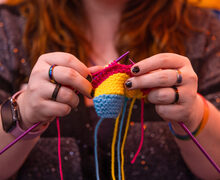Co-founder of Pussyhat Project speaks at School of Architecture
Molly Gibbs | Asst. Photo Editor
Jayna Zweiman, a co-founder of the Pussyhat Project, spoke in Slocum Hall on Monday.
The Syracuse University School of Architecture welcomed co-creator and co-founder of the Pussyhat Project, Jayna Zweiman, to campus Monday night for a presentation in Slocum Hall.
The Pussyhat Project, an international network and movement of women’s rights supporters, gained attention in 2017 during peaceful protests after President Donald Trump’s election. It has been called the largest crowd-sourced art advocacy project in history.
The “pussyhats” are pink and pointy-eared. The hats symbolize support for women’s issues and were worn during the Women’s March on Washington, D.C.
“This is something that you can create with your hands, that can convince someone else,” Zweiman said.
Zweiman said she developed the project after discovering a love for knitting. She started knitting while recovering from an accident.
Immediately after the results were announced indicating then-presidential candidate Donald Trump won on election night, Zweiman said she went to her local knittery. Her response to Trump’s election was a crowd-sourced approach to advocacy across a network of 175 local garment stores. Zweiman and others created pussyhats for people to send or wear themselves to women’s marches following Trump’s inauguration.
What ensued was a collective effort nationwide by thousands of women to knit and distribute thousands of pussyhats.
The Pussyhat Project supports women’s issues and the overarching women’s movement, but it has also become an intergenerational mechanism for women to support other women.
“I really love that it’s a project that’s very trans-generation, and that people who aren’t on social media can be a part of it,” Zweiman said.
The idea of women supporting women was fundamental to the Pussyhat Project, she added.
“Seeing grandmas making hats for their granddaughters and vice versa shows it’s not just in one direction,” Zweiman said.
The overarching objective of the project is “about changing spaces and how we live,” Zweiman said. The hats created a way for people who couldn’t attend women’s marches to stand in solidarity with the women’s rights movement. There is a great diversity in what people wear the hats for, Zweiman said, and “everyone is in charge of how they wear it.”
Zweiman’s latest project in craftivism is the “Welcome Blanket,” she said. The objective of the project is to re-conceptualize the 2,000-mile border wall proposed by Trump’s administration as 2,000 miles of yarn by making individual welcome blankets for new immigrants. Zweiman is working with the Refugee Resettlement Agency to create a project that symbolizes “2,000 miles of inclusionary distance.”
Zweiman plans on developing the Pussyhat Project into a nonprofit organization focused on creating an information network for intersectional women’s issues, and a design incubator to promote more “craftivist” projects, she said.
The takeaway from this experience, and the motivation for Zweiman moving forward is connected to her original objective, that “design can be an agent of change,” she said.
“Overall, it created this image of such power made by individuals,” Zweiman said. “That’s empowering for a lot of people to see.”
Published on March 5, 2018 at 10:08 pm
Contact Joshua: jcarney@syr.edu





